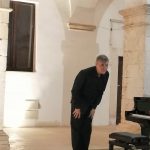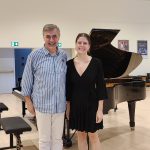Fanfare
CHOPIN Piano Concertos Nos. 1 and 2. Fantasy on Polish Airs. Krakowiak.Variations on Mozart’s “Là ci darem la mano.” Andante spianato and Grande Polonaise brillante
CHOPIN Piano Concertos Nos. 1 and 2. Fantasy on Polish Airs. Krakowiak.Variations on Mozart’s “Là ci darem la mano.” Andante spianato and Grande Polonaise brillante
Chopin pianists are a breed apart. Sovereign technique must be taken for granted. Yet Chopin playing never can be mere bravura. Of all the great composers, Chopin is the one who speaks most to the masses. A pianist must identify fully with the popular elements in his music, the singing line and the dance rhythms. Chopin playing rarely succeeds if it descends to the abstract or the arcane. Then there is the issue of Chopin’s harmony, which a player must master to create the special ambience of his music. Put all together, these elements should coalesce into a sound one regards as quintessentially Chopin. One of the reasons Arthur Rubinstein was widely regarded as a fine Chopin player is that, whatever you thought of his interpretations, his sound after a few bars made you think, “Chopin.” Oleg Marshev has this same gift. I love his playing. It was interesting to compare his set of the complete works for piano and orchestra with that of Garrick Ohlsson, certainly an eminent Chopin player. Where Ohlsson is concerned with the microeconomics of Chopin playing, Marshev is more in tune with the macroeconomics. For Ohlsson, playing these works is about getting a rhythm right here, an accent right there. Marshev, however, is more interested in the sweep of the music, its cascading structures. No matter how intricately he spins out its expression, the pulse of Chopin’s long line always is maintained. Ohlsson is like a riveter working on a building, while Marshev is its architect. Marshev is the kind of complete artist for whom the entire layout of his interpretation of a piece of music is implicit right from the very beginning of his playing it. And here, after a few bars, you hear yourself think, “Ah, Chopin!” No recording of Chopin’s music in the past few years has given me more pleasure than this one.
The solo part of the First Concerto for Marshev starts with an autumnal feeling, like leaves falling from the trees. The B section is filled with regret, as if you can feel your heart beating. In the return of the A material at the start of the development, you catch your breath from a chill in the air. Marshev’s last statement of the B music borders on heartbreak. A moonlit reverie dominates the slow movement, with the white light bringing out an unearthly color from the grass. The B section has a slightly Slavic feel. In the concluding rondo, Marshev never loses sight of the underlying dance rhythms. His ease of execution is remarkable. In this concerto and throughout the set, David Porcelijn’s accompaniment is alert, vivid, and frequently exciting. The South Denmark Philharmonic is a well drilled ensemble of 65 players, whose balance with Marshev is good. The sounds of the principal horn, oboe, and bassoon are a little raw, but you get used to them. The next work, the Fantasy on Polish Airs, is perhaps the hardest of these to bring off. Marshev delivers the sentimental thematic material with great poise. Passage work which seems meaningless in other hands here creates washes of color, along with intricate rhythms in the concluding popular dance. Marshev views Krakowiak as an opportunity to display all the charm and panache of the complete virtuoso. Neither he nor Porcelijn loses sight of a certain amount of nationalistic flag waving that goes one here. Marshev’s playing of the coda has balletic grace.
The Second Concerto begins CD 2. In its opening movement, despite the maturity of Chopin’s musical expression, Marshev never lets you overlook the passion of a 19 year old. His treatment of the B section is a real tear jerker. Marshev’s use of rubato keeps you on the edge of your seat. He juxtaposes tender moments with brilliant passage work, like the sea crashing into the shore. The slow movement is the high point of the album. Marshev’s delicate and poignant phrasing takes your breath away. Chopin’s melodic line often threatens to vanish into silence or stillness. The string tremolo passage finds the composer agitated yet pensive. The recapitulation is like a transfiguration. To borrow a phrase from Philip Larkin that Simone Dinnerstein used in another context, this is music “like something almost being said.” The last movement provides a respite from emotional crisis. Marshev’s playing is piquant, with just an occasional bit of turbulence to remind us of where we have been. The coda, while bravura, still suggests the dark underside of Chopin’s imagination. The Variations on Mozart’s “Là ci darem la mano” is filled here with the genius Robert Schumann discovered in it. In the introduction, Marshevweaves a tapestry of inferences of the theme. His treatment of the first variation prefigures the etudes Chopin soon would begin composing. The fifth variation finds Marshev darkly intimating Don Giovanni’s eventual fate. He sends off sparks in the concluding Alla Polacca, while maintaining an overcast color.
The Andante spianato and Grande Polonaise brillante ends the program. Marshev’sAndante is suave, with the elegance of the Parisian aristocratic salons Chopin frequented—a world of money, comfort, and ease. In the Polonaise, Marshev savors Chopin’s gift for improvisation, as the tunes branch out in all directions. The pianist strikes just the right balance between Chopin the nationalist figure and the cosmopolitan artist. Throughout this album, the sound engineering is warm and full, if slightly veiled. My favorite recording of the First Concerto is Géza Anda’s. I prefer Witold Malcuzynski’s stereo version for No. 2. An interesting CD of the four shorter works, if not on the same level as Marshev, is the period performance album by Nelson Goerner and Frans Brüggen. Marshev’s accounts of all six works are now my favorite digital versions of this music. I rarely have heard Chopin playing of such sensitivity and total accomplishment. I eagerly await more Chopin from this pianist.
Dave Saemann



Marshev would seem to be the Jorge Bolet of our times: great but under-appreciated artist, with sovereign technique, deep feeling and refined taste.